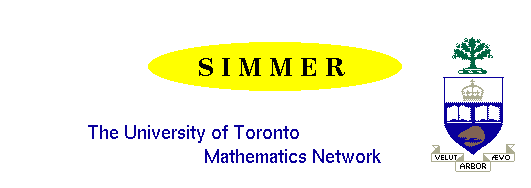
October 2000
SIMMER Presentation
The first SIMMER meeting this year was held on Saturday,
October 14, 2000, 1:30 pm - 4:30 pm. This was a joint session with this year's SOAR
Reunion.
Here is a description of the session followed by some
references and questions posed by the two presenters.
Title: “A
Tale of Two Series”
Presenters: Dr. Greg Martin and Emmanuel Knafo
(Mathematics, University of Toronto)
Part 1: Do you hate fractions? The way they just sit there so smug
over their exactness? The way the denominator lets the numerator walk all
over it? Well, this SIMMER is for you, because we're going to talk about
decimals! We'll take a look at the series of digits making up the decimal
expansions of various fractions, thinking about when they terminate and when
they repeat and trying to understand how long it takes the decimal expansions to
start repeating. Surprisingly, we'll find connections to topics such as Euler's
phi function and factorizations of numbers.
Part 2: Do you hate decimals? The way they take up so much space?
The way they just go on and on and on, never stopping to let anyone get a digit
in edgewise? Well, this SIMMER is for you, because we're going to talk
about fractions! We'll take a look at the series of numbers making up the
continued fraction representation of various numbers, thinking about when they
terminate and when they repeat and trying to understand how to calculate the
continued fractions in the first place. Surprisingly, we'll find connections to
topics such as the Euclidean algorithm and the quadratic formula.
In their usual creative manner Greg and Emmanuel divided the 3
hours into 7 equal parts as follows:
1:30-1:55:42.857142
1:55:42.857142-2:21:25.714285
2:21:25.714285-2:47:08.571428
2:47:08.571428-3:12:51.428571
3:12:51.428571-3:38:34.285714
3:38:34.285714-4:04:17.142857
4:04:17.142857-4:30
The first and last three portions were spent on Parts A and B
respectively. The middle portion were for a break, refreshments and for
informally discussing the "Reunion Problems" students were given on
the last day of this year's SOAR Number Theory 'camp'.
References:
Exploring the Real Numbers", Stevenson (Prentice Hall)
* Part I: Section 3.1
* Part II: Sections 3.3, 4.3
"Number Theory with Computer Applications" by
Kumanduri & Romero (Prentice Hall)
* Part I: pp. 192-193, problem #1
* Part II: Sections 11.1, 11.4
"Elementary Number Theory and its applications",
Rosen (Addison-Wesley)
* Part I: Section 12.1
* Part II: Section 12.2-12.4
Problems to think about:
Part 1:
* Find a number n such that the decimal expansion of 1/n has period 3.
(That is, 1/n = 0.abcabcabcabcabcabc... for some digits a, b, and c.)
* Find all numbers n with that property.
* Do the same with period 3 replaced by period 4 and period 5.
* In general, what is the relationship between the periods of the decimal
expansions of 1/m, 1/n, and 1/mn?
* Find numbers n such that the decimal expansion of 1/n has period 15; period
20; period 60.
Part 2:
* Expand the rational fractions 17/3 , 3/17 , and 8/1 into finite simple continued fractions. From the continued fraction expansions of 17/3 and 3/17, can you generalize and show how the continued fraction expansion for a/b relates to the one for b/a ? What is the continued fraction expansion of an integer ?
* Evaluate the infinite continued fractions of <1,1,1,1,...> ,
<2,1,1,1,1,...> , <2,3,1,1,1,1,...> , <1,2,1,2,1,2,...> , <1,3,1,2,1,2,1,2,...> , <3,6,7,3,6,7,3,6,7,...> , and <5,6,9,3,3,6,7,3,6,7,3,6,7,...> .
* Expand each of the following as an infinite simple continued fraction:
sqrt(2) , sqrt(2) - 1 , sqrt(2) / 2 , sqrt(3) , and 1/sqrt(3) .
Note sqrt stands for square root.
Back to the SIMMER
home page
This page was last updated: October 30, 2000

